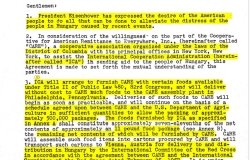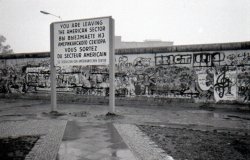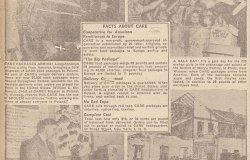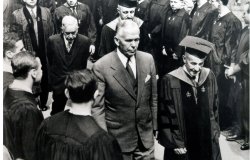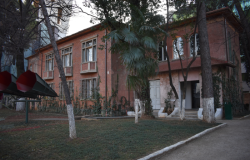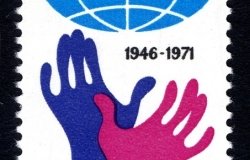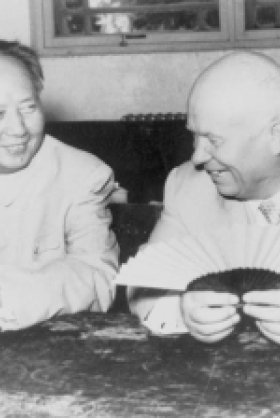Lives and Consequences: The Local Impact of the Cold War
The International Security Studies Program at Yale University and the Cold War International History Project team up for a conference on diplomatic history from a local perspective. The conference will analyze and discuss ways in which localities experienced the Cold War and communities influenced the conflict's larger actors.
Overview
Lives and Consequences: The Local History of the Cold War
A Conference Report by
Jeffery Engel
Cold War scholars from three continents met at Yale University in New Haven, Connecticut, during the third week of April, 2003, for a conference co-sponsored by Yale's International Security Studies program and the Cold War International History Project entitled "Lives and Consequences: the Local History of the Cold War." Their goal was to explore diplomacy's real-world effects, to illuminate what scholars and pundits so often take for granted, but so rarely examine: that diplomacy matters to lives, to regions, to communities around the world. The invited participants were given the imposing goal of challenging the traditional view of diplomatic history as solely a tale of nations and national policymakers. They were instead told to push the boundaries of international history into the lives and the communities of peoples the world over: those places and people so often affected by global affairs, but whose stories are rarely (if ever) investigated by foreign affairs scholars.[1] What follows is a brief description of their topics and findings.
Following introduction remarks by conference coordinator Jeffrey Engel of Yale University, the conference featured four sessions, each devoted to a broad theme of Cold War history. First was "Education and the Arts," and Yale University's Seth Fein began the weekend's proceedings with his paper, "Cinematic Cold War and Mexico City Newsreels: Between Film and Television, Mexico and the United States, the 1950s and 1960s." Fein's work explored the way American policymakers of the middle Cold War years used Mexican cinema and newsreels as a vehicle for disseminating their Cold War messages to the Mexican people and throughout Latin America. They purposefully blurred the lines between art, news, and propaganda, and Fein demonstrated the way Washington's financial support proved crucial to Mexican newsreel producers of the period, whose films in turn offered a distinctly American message. What Mexicans saw in the theater, in sum, was a direct result of Washington's Cold War imperatives.
Hiroshi Kitamura (University of Wisconsin-Madison) proved much of the same for Japan, as his work, derived from his dissertation, showed the cinematic dissemination of American Cold War ideals during the occupation of Japan. Entitled "Hollywood and the Culture of Film Exhibition in Occupied Japan, 1946-1951," Kitamura's essay moved beyond the newsreels Fein explored in order to show not only the way Cold War themes permeated American feature films exported to Japan, but also the way American policymakers in charge of the occupation purposefully selected for exhibition only those films deemed sufficiently pro-American. Film was in this way a vehicle for Cold War propaganda, and the meeting place of Japanese and American cultures only months after the close of their bitter war. His is also a distinctly Cold War tale, as Kitamura demonstrated American efforts to remake Japan in a more democratic image through film and through the imposition of Western film culture and norms including hygiene, building structures, and even the way seats to shows were sold. Films could turn the Japanese towards the West, Washington reasoned, and in doing so help keep the country in the Western fold.
Jeremi Suri (University of Wisconsin-Madison) continued this panel's exploration of the Cold War's impact on education and the arts by illustrating the diplomatic battleground that was Cold War Berlin though an examination of the city's Free University. His paper, entitled "The Cultural Contradictions of Cold War Education: The Case of West Berlin," traced the University's explicit creation as a forum for Western values and education. By the 1960s, however, student protest and government movements, in effect the use of those Western values, began to rankle the University's founders, who believed in a more staid appreciation of Western norms. Suri's work in this way linked changes in the international system with changes in one place, in this case in contentious West Berlin, proving beyond doubt that international affairs have distinct local effects.
Yale University's Gaddis Smith concluded this panel with his evocative work entitled "The Cold War and Yale." Smith traced the impact of the superpower conflict upon the University's curriculum, its faculty, and even its social norms. Students and faculty alike were careful to toe the appropriate political line, he argued, having witnessed the consequences of overt dissent from the pro-American line favored by the University's administration. The Cold War's impact even permeated their social lives, as the University hired (and then fired) security officers fresh from J. Edgar Hoover's FBI who at times cared more for rooting out suspected communist sympathizers than for maintaining the peace. Having personally witnessed this period at Yale, but having the benefit of extensive archival research as part of his forthcoming book on Yale, Smith's presentation mixed the personal with the professional to demonstrate not only the way New Haven and Yale changed during the Cold War, but more importantly the way the Cold War changed the city and its institution. Andrew Preston (Yale University) chaired this panel.
The conference focused next on the way Cold War diplomacy affected social relations, with a panel chaired by Michael Auslin (Yale University). Thomas Borstelmann (Cornell University) began this session with a broad-based paper entitled "The American South and the Cold War." Cold War diplomacy and the very structure of the Cold War changed this pivotal American region, Borstelmann argued. Increased military spending pumped untold millions into the region's economy, helping to train its workforce and ultimately contributing to the South's dramatic social changes throughout this period. Without the Cold War, he ultimately concludes, the South would not possess its influential place in contemporary American politics and social life.
Frank Costigliola (The University of Connecticut) also saw the Cold War's human impact, though his exploration of Soviet-American relations on the ground in Poland at the close of the Second World War was far more focused in scope. His paper, entitled "'Unwashed, Unshaven, Crawling with Vermin, Eating Raw Meat': Constructions of Identity by Americans, British, and Russians in Poland, 1944-45," demonstrated the way nascent Cold War imperatives shaped East-West interactions among soldiers, diplomats, and most particularly downed airmen during the final months of the war. The way American and British soldiers were treated behind Soviet lines, moreover, sharply affected American diplomacy in particular, as policymakers such as Averill Harriman and even Harry Truman used examples (some rumors, some facts) of Soviet ill-treatment to justify their hard-line anti-Soviet stance at Potsdam and beyond. Cold War diplomacy in this way affected life on the ground, but life on the ground also in turn shaped and fundamentally altered superpower relations, thereby exacerbating the already tense superpower competition during the Cold War's first days.
While Costigliola focused on the Cold War's start, Tim Snyder (Yale University) focused on its end. His paper, "From Paris to Warsaw about Moscow: Jerzy Giedroyc's Grand Strategy for the Post-Cold War World," explored the strategic thinking of Polish expatriates exiled to Paris throughout much of the Cold War. Their influential journal, entitled Kultura, helped frame Poland's eventual resistance to Soviet influence and rule by the close of the 1980s, and more dramatically, helped shape a peaceful transformation for Eastern Europe at the close of the Cold War. While some predicted ancient land claims and ethnic hostilities might derail the region's pacific future, Kultura's writers formulated a middle-path for Poland, one that simultaneously promoted stronger ties with regional neighbors and stronger ties with the West. The Cold War in Eastern Europe in this way shaped intellectual work in Paris, whose efforts helped restore and retain Polish sovereignty by the 1990s.
The first day of panels at an end, participants and invited guests retired to dinner and to the conference's keynote address by John Lewis Gaddis, Acting Director of Yale's International Security Studies. Taking a cue from his recently published exploration on the theory and practice of history, The Landscape of History, Gaddis presented an overview of the conference theme with particular attention to the contribution mathematics offers for historians interested in the Cold War's local effects. Fractals are the key to understanding the Cold War's geopolitical and local effects, he said. "The key idea here is self-similarity across scale. Things look much the same, whether you're viewing them from a great distance, or close up, or from somewhere in between." This conference forced historians, most trained to look at the international effects of policies and decisions, to explore the local effects of those same decisions. Using examples drawn from six of the conference papers, Gaddis argued that the process of exploring the local in diplomatic history was the process historians of all genres had been trained to perform. "So what is the connection between the global and the local in Cold War history? It's really not much different, I think, from the difference between the general and the particular in all of history. We all make generalizations, but only after we've connected them to particularities that exemplify, qualify, amplify, or perhaps even reify. What is this, though, if not also fractal history, a search for self-similarities across scale?" Diplomatic and international historians have much to learn from the focus on localities in their work, for this is the work they were trained to do.
The Conference's second day began with a panel chaired by Ted Bromund (Yale University) devoted to exploring the Cold War's impact upon physical landscapes and demography. Richard Kirkendall (University of Washington) began the day's proceedings with his work entitled "The Early Cold War and Aerospace in the American Northwest." Kirkendall showed the Cold War's broad effects on the region through economic and demographic change, but then focused on one of the region's primary industries, aerospace, and before Microsoft its largest employer, Boeing. He argued that the company's and the region's fortunes were inherently intertwined, with prosperity for one meaning the same for the other, and that government spending in particular on lucrative military programs such as the KC-135 tanker and the B-52 bomber "saved" Seattle. The state's leading politicians, men like Senators Henry "Scoop" Jackson and Warren Magnusson, considered military spending their salvation as much as their security and the region's remarkable Cold War growth owed much to the Pentagon and to their own political influence.
Kirkendall's examination of aerospace and Cold War diplomacy in one region during the early Cold War was followed by Michael Oden (University of Texas), whose paper "When the Movie's Over: The Post-Cold War Restructuring of Los Angeles," explored California's fate after the aerospace decline at the end of the Cold War. Tens of thousands of well-paying defense sector jobs were lost as part of America's "peace dividend" at the close of the superpower conflict, and their removal from the local economy transformed the region. The change prompted recession and ultimately renewal of the state's vaunted technology industry, and transformed California from a swing-state in national elections to a solid bastion for the Democratic Party. White-collared Caucasian home-owners left in droves following the loss of their jobs, replaced largely by Latin American and Asian immigrants more predisposed to vote a liberal line. Emblematic of this transformation was the political demise of Congressman Robert "B-1" Dornan, a staunch conservative and defense supporter, in favor of Loretta Sanchez, a Hispanic Democrat. As Oden shows, Los Angeles was transformed not once but twice by the Cold War: first when it grew in line with superpower tensions, and then later when the end of Cold War military spending prompted massive changes in the region.
Anita Seth (Yale University) followed next with her own exploration of aerospace as a lens through which to view Cold War effects, though her paper focused primarily upon the local impact of this period's diplomacy deep within the Soviet Union. In "Witnessing the Soviet Military-Industrial Complex in Novosibirsk, 1945-1950," Seth traced the transformation of this Siberian city from a regional trading post to a centerpiece of Soviet industrial production. Novosibrisk was home to significant aircraft production facilities during the Second World War, but its factories largely closed at the end of the conflict. The city's population declined precipitously as a result, and city leaders turned even to bicycle production in their effort to sustain their local economy. All this changed with the dramatic escalation of East-West tensions, and by 1959, the city proved of such importance to the Soviet economy that it was chosen to host Vice-President Richard Nixon in his travels across the country. The Cold War saved this Siberian city, even if it took military production to sustain the region.
The Cold War proved potentially more poisonous to one Scottish city, according to Alan Dobson (University of Dundee) and Charlie Whitham (King's College, London). Their work, "Project LAMACHUS: The Cold War Comes to Scotland. The Holy Loch US Nuclear Submarine Base and It Impact on Scotland 1959-1974," reveals the environmental impact of America's nuclear submarine base in Scotland, and most specifically the tremendous rise in local radioactivity levels because of submarine activity. Their work explores the economic and political impact of this base upon the local community, but it is to the base's long-term health and environmental consequences that the bulk of their research points. What was at once a symbol of Anglo-American cooperation and of their united stand against international communism became, in time, a deadly factor in Scottish life. The Cold War's local impact, in Scotland, lay silently in the water.
The conference's final panel, chaired by Katherine Carté Engel (Rutgers University), explored the way Cold War diplomacy affected specific regions far removed from the traditional halls of power. Arvid Nelson (Yale University) began this final session with his work entitled "'A Law Would Be Good.' Land Reform and Changes in the Natural Landscape in the Soviet Zone of Germany," a piece that explored the Cold War's impact on forestry and land use practices in Eastern Germany. The landscape reveals the heart and true meanings of governments and politics, Nelson argues, for land use reflects what policymakers truly believe about their society. In the case of East Germany, policymakers believed the land could be ordered and made useful for the state. Reparations paid to Germany's Soviet conquerors decimated the region's natural resources, and East Germany's desire to divide the land equally among workers disrupted its historic efficiency and productivity. By placing politics over rational usage, he argues, East German officials allowed their Cold War rhetoric to disrupt what history taught them about proper land management, and in doing so, they damaged the earth and weakened their own society. The Cold War had a tremendous environmental effect in East Germany, Nelson shows, but it was not a coincidental one. Rather, East Germany's landscape suffered as a result of conscious ideologically-driven decisions.
American policymakers proved much more benign in their land use policies, though they too recognized the importance of place and geography in choosing their Cold War defenses. This is part of Catherine McNicol Stock's contribution to this conference, with her exploration of the impact of America's strategic missile program on the American plains. In "There is No Nowhere Anymore": The Installation of Intercontinental Ballistic Missiles on the Northern Plains, 1950-1975," Stock emphasizes that the Cold War's impact on South Dakota was in many ways no different from the impact from the New Deal and other federal programs. Each helped modernize and transform the region, and each made the federal government a vital player in the region's economy. The Cold War simply replaced New Deal spending with Pentagon spending, though the installation of missiles did leave a lasting mark on the region's natural political isolationism, given that the Dakotas were suddenly primary targets for prospective Soviet nuclear assault. "Militarization did significantly effect culture and society on the northern plains but it wasn't transformed into something "profoundly different' (sic!)," she argues. Rather, "ongoing tension between center and periphery is [the] important story of the Cold War" for the American Plains.
Superpower tensions also left their mark on regions far removed from either the United States or the Soviet Union. This is the point of the conference's final two presenters, beginning with Jeremy Ball (University of California—Los Angeles), whose work "At Least in those days we had enough to eat. Colonialism, Independence and the Cold War in Catumbela, Angola, 1974-77," explored the way superpower policies warped and ultimately transformed life in Angola during the mid-1970s. In focusing on one plantation, in this case in Catumbela, Ball's work takes what could be viewed as an international affair or civil war with geopolitical implications and shows what war and Cold War mean to lives and to one locale. The conflict disrupted the plantation, this is true. But it ironically fostered a greater appreciation among its survivors for an earlier age, when stability was more a reality and a hope. Eventually the plantation closed, and with it, went the livelihood its workers and inhabitants had come to take for granted, and come to recognize they'd needed. Cold War diplomacy, he shows, made these changes happen.
In the final presentation at this Yale/CWIHP conference Luis Rodriques (Instituto Superior de Ciências do Trabalho e da Empresa in Lisbon), explored the human impact of Soviet-American diplomacy upon regions far removed from either capital. His focus, in a paper entitled "Cold War and Colonialism: The Case of East Timor," lay far from Europe or North America, though this location did not keep Sino-American pressures from having their effect. Rather, as he shows using newly declassified documents from Portugal and the United States, American support proved crucial in Indonesia's plans to crack-down on its breakaway region in East Timor. Indonesian troops used American-made equipment and military supplies in their invasion, he argues, a fact American officials not only recognized but also tacitly endorsed. Indeed, American endorsement proved the final green-light needed by the Indonesian regime before launching its assault. East Timor became a pawn in American Cold War geopolitics, and as Rodrigues argues, their people suffered as a result.
In coming to New Haven through the cooperation of CWIHP and Yale's International Secuirty Studies, these scholars each explored the local impact of the Cold War. Each strove, in their own way, to advance the field, and to show the intersection of disciplines that makes for good international history. The Cold War had a real impact, they proved, one with human, environmental, political and social costs.[2]
[1]With CWIHP's assistance, their work is currently being edited for publication as a collected volume.
[2]Work is currently underway to see their collective projects published in an edited collection, through the assistance of the Woodrow Wilson Center Press. In this medium, they work might see its greatest impact.
Hosted By

Cold War International History Project
The Cold War International History Project supports the full and prompt release of historical materials by governments on all sides of the Cold War. Through an award winning Digital Archive, the Project allows scholars, journalists, students, and the interested public to reassess the Cold War and its many contemporary legacies. It is part of the Wilson Center's History and Public Policy Program. Read more
Thank you for your interest in this event. Please send any feedback or questions to our Events staff.
